'47 Kurtis-Kraft Midget Racer
Frank Miller and Fred Offenhauser
In the early 1900s Framk Miller built some of the fastest, most beautiful and innovative open wheel race cars of all time.
In 1913, Miller hired a 25 year old machinist named Fred Offenhauser who learned his trade working for the railroad. By 1914 Miller made Offenhauser the head of his engine shop.
That same year, Bob Burman was campaigning a Peughot Grand Prix car in the United States. With the outbreak of WW1 in Europe, the Peugeot team couldn't return home, so maintenance of the car fell to Miller and his shop of talented workers.
Miller and Offenhauser were so impressed with the state-of-the-art Peughot engine and its dual overhead cams and multi valve per cylinder engine, that they incorporated many of its features into there own racing engine designs.
Miller's engines not only powered his own cars but those of other racers too, winning the Indy 500 multiple times. Nine times for Miller cars ,and three times for cars powered by Miller engines, not to mention how many 2nd an 3rd place finishes were achieved.
With Offenhausers constant development they turned Miller's straight 8 racing engine into a 4 cylinder and marketed it for speed boat racing.
It did well setting numerous records, and winning many competitions in the boat classes.
In 1930 the little 4 cylinder was installed in a race car and it set an international land speed record of 144.895 mph (233.186 kp/h).
In 1933 Miller and the company that he had sold much of his equipment and rights too, went bankrupt.
Fred Offenhauser purchased the rights and drawings to the engines and all the equipment and moved to a shop down the street to start his own business.
He kept refining and developing the motors into the famous "Offy" 4 cylinder engines we know today.
Frank Kurtis
In the 1930s Indy car, and Midget car racing were big, and Frank Kurtis wanted to go racing. With the construction of his own Midget racer, Kurtis started his own company. By 1941 he had already designed and built 2 Indy cars, one of them with a beautiful low slung chassis for the famed Novi special, and powered by the equally famous Novi engine designed and built by Fred Offenhauser and fellow ex-Miller employee Leo Goosen.
Kurtis's Indy car heydays were the 1950s, winning in 1950, '51, '53, '54, and '55.
Throuout the 1940s, Kurtiss designed what was probably his most famious design. He continuously worked to develop his Midget design, even though WW2, wile filling contracts with the military building children's toys, to keep the business going.
His new Midget was innovative.
It featured a full tube chassis, torsion bar suspension, magnesium Hallibrand wheels, and was powered by the mighty "Offy" 4 cylinder racing engine.
The car was ready for production by the time the 1946 race season started.
In all Kurtis-Kraft produced 550 "turn-key" Midgets from '46 to '62 and another 600 in kit form with different options including the choice of V8-60 Ford flathead power to make it a little easier on the wallet.
These cars dominated race tracks all across the United States for decades.
In 1956 Frank left Kurtis-Kraft to start the "Frank Kurtis Company" and continued building Midget racers, go-karts, and sports cars.
Later the company shifted its focus to airplane design and it also had contracts with Lockheed to produce the AG330 Stat cart for the SR-71Blackbird. Powered by two 401ci. Buick nailheads (later versions had 454ci big block Chevy engines) all with straight open pipes, Just to start the two Prat &Whitney J-58s that powered the Blackbird.
The Model
This started out as the Monogram Midget racer. Originally released in 1954, (my kit is a reissue) it was Monogram's first injection molded plastic kit. # P1, followed by a '32 Ford hiboy roadster #P2, and a Kurtis Indy Roadster #P3. "P" meaning plastic.
Anyone who has ever built this kit over the last nearly 70 years (yes, this kit will be 70 years old now in a few weeks, wow) knows how basic it is, but the shape is dead on Kurtis-Kraft!
I wanted to see what I could do to jazz it up a bit so here we are.
I apologize for the bad in progress pitchers, I had to take photos of photos on my old phone, as I couldn't transfer them.
I built a tube chassis mimicking the real cars frame. I built and engine turned a new firewall and dashboard. Photo copied some gages from a Street Rodder Magazine and made bezels and lenses for them. I built the steering wheel, new nerf bars front and rear, and new more accurate radius rods. The seat is Milliput putty painted with oils to look like leather. The hand fuel pressure pump is made from brass tube and wrist watch parts, as are parts of the friction shocks, and some missolainious hardware.
The tires are from the old Monogram Green Hornet Model-T Ford drag car kit and the wheels are from the Revell Orange Crate '32 Ford sedan kit, both of them being 1/25 scale kits. This worked out ok because the Midget kit is actually more like 1/20th scale so the tire/wheel combo looks rite.
The engine is the kit part modified with scratch built finned aluminum side covers and breathers. Modified Stromburg carbs made to look like sidedraft units. And the kits header was modified with a piece of aluminum tubing.
The chrome was done with a Moloto chrome paint pen. The body was closed up around the guts like an airplane model, seams filled and painted with Testors metallic blue liquor.
I hand lettered the #3 on the nose and tail sections and added an Eddelbrok decal to the hood sides before a couple coats of K2 clear.
Final assembly was adding the axles and rolling stock, a wind screen made from a pop bottle, the scratch built grill for the nose and a few odds and ends.
So their you have it! Its not a specific car just my homage to all the racers who burned up the tracks in these little numbers. I think these cars were so cool and I love this model. I hope everyone enjoys taking a look too, and please forgives me for the length of this article. I know its long, but it's no where near doing justice to these American automobile racing legands.
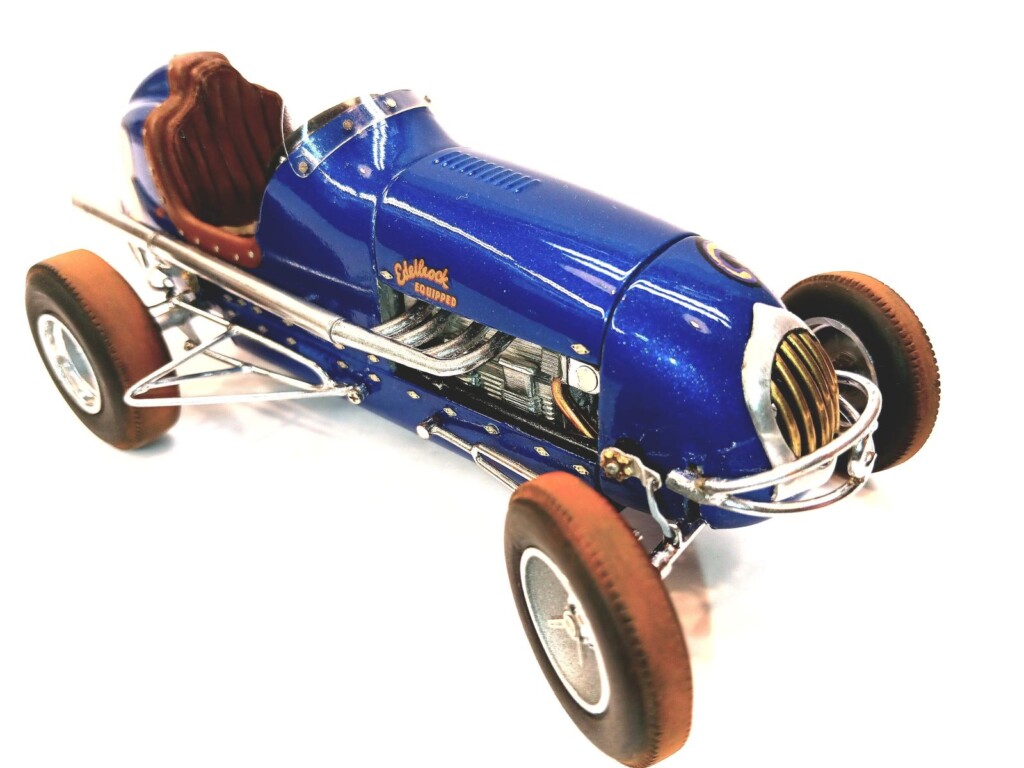
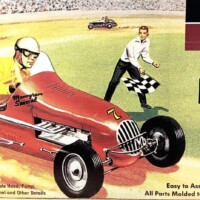
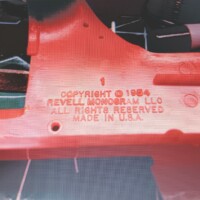
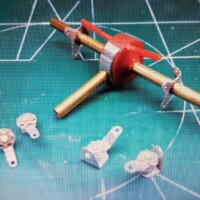

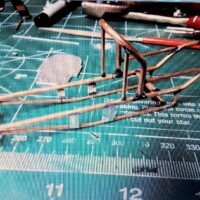
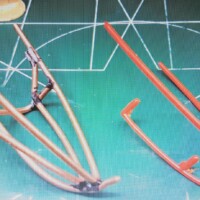
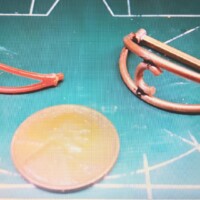
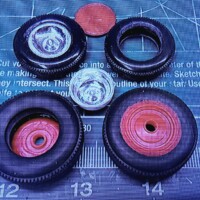

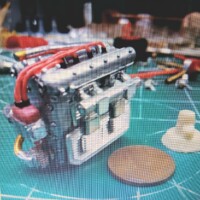
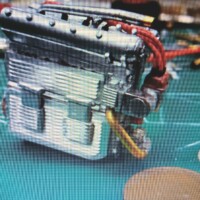
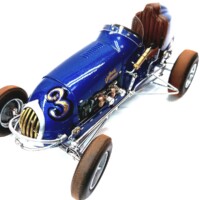
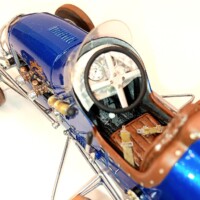
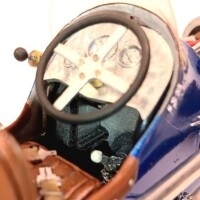
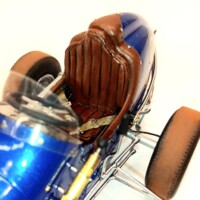
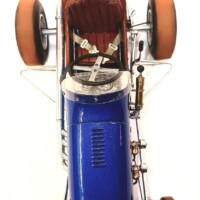
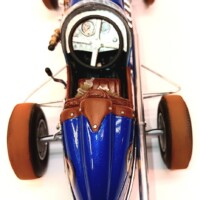
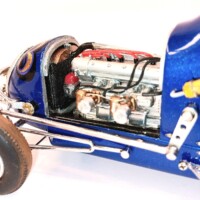
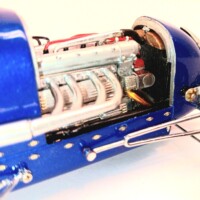

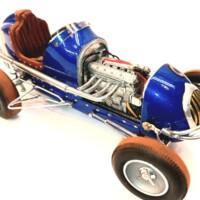
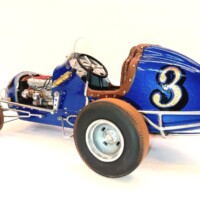
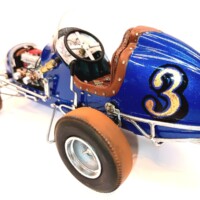
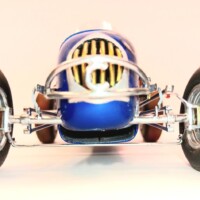
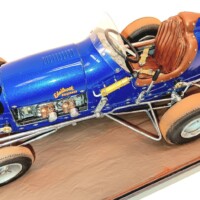
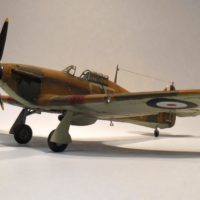
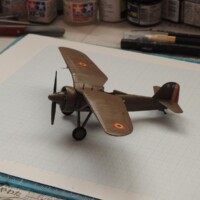
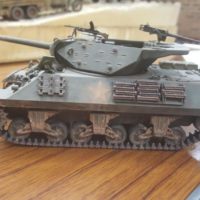
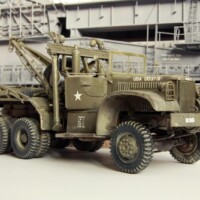
That’s a giant of a midget, Clint, very well done on the scratch built details, the blue finish, and the weathering on the tyres. The history was very informative as well. Thank you for sharing this with us.
Thanks so much George. It was a fun build.
This is a wonderful model by any means, Clint! Your massive extra work, both quantity and quality wise, had resulted in an equally massive departure from the original simplistic Monogram kit to this jewel.
Congratulations!
Thanks Spiros. I appreciate you comments. It's a neat old kit norther how you build it. I want to build a couple more in different levels of detail.
Simply stunning work Clint, really shows off how much you enjoy this racer and it's history.
Thanks Tom. I really do love these old racers, it was a totally different time for sure.
Nicely done, Clint.
Thank you Rafi, very much.
Clint, I don't understand model cars at all, but your model car looks absolutely gorgeous.
Wow. That is some mighty fine work, Clint! Your scratch-built details really elevate the kit, and the result is magnificent!
That is some mighty fine work, Clint! Your scratch-built details really elevate the kit, and the result is magnificent! 
May I add a bit of info regarding the Miller engines @curtisshawk? I guess the rarest of those were two DOHC V-8s, both of which apparently survive today. They were also mechanical "works of art".
https://www.museumofamericanspeed.org/1932miller308.html
That's just beautiful. Miller, Offenhauser and Goosen were really mechanical geniuses, definitely ahead of there time. The car were beautiful, the level of finish was always outstanding, and there performance was top notch.
This is superb work, Clint. All that very good scratchbuilding and extra detailing really paid off. The result is very realistic and the model is a real beauty.
Thank you Mr. Cleaver! Coming from you, it's a real compliment. This is the kind of stuff I really love, anything that's fast, with piston power, and old!
Absolutely amazing work done, Clint @curtisshawk
All the extras were definitely worth it.
Nice article as well.
Thanks John. These early Monogram kits were usually pretty accurate as far as shape went, so there great jumping off points for this kind of upgrading.
Your build is marvelous and the history behind it is fascinating! @curtisshawk
I appreciate that John. There is so much to the history that I left out, not on purpose, just to keep it brief. These men and their cars were amazing, there should be more kits of them. Sadly there is very few. I might try to scratch build a complete Miller Indy car at some point.
Clint Miller (@curtisshawk)
I really enjoyed reading the article, probably just as much as I did the pictures. I'm an old Mopar gear head myself. Back in the day I drag raced a Dodge Challenger with a 440 V-8 and a 4 speed. I have helped build several circle track race cars, plus I worked as an automotive machinist. Doing this for a living for a while, I have built numerous race engines over the years. These men's names you mentioned I had heard before, but I never knew the story behind the men. Thank you for telling their part in making the legend.
I'm from Daytona Beach originally, growing up here and living there for a good part of my life. Our town and nearby Ormond Beach is loaded with history of racing automobiles... and even airplanes on the beach back during the barn storming days. If it had wheels they would race it here. Daytona is known for the NASCAR races, Bike Week, and Ormond Beach is known as "The Birthplace of Speed". I have talked with Smokey Yunik on many occasions and I have been buy his garage just as many. My Dad was offered a job by Bill France Sr., to be the Captain of his private yacht, but he turned it down because he would have been on call and Dad didn't want to leave us at home for an extended period of time.
Funny thing you mentioned a Buick nail head 401... In order to get my driver's license, I took my driving test in a 2 door hardtop 1962 Buick Invicta that was powered by a "nail head" 401. If you ever saw the valve covers you would know why this engine got it's name. There are two big bolts in the center of each valve cover that hold it down on the cylinder head. These bolts resembled two big nails, and since they were the only thing that held the valve cover in place, it was joked that the covers were nailed in place because nothing else was holding them on...
I REALLY liked you article. Your scratch building skills are excellent as well. Also the rear end assembly looks like the ones used in the Fords back in the 1920's and 30's. They split apart right down the middle. Excellent attention to all of the details.
Thanks for sharing this with us. I'm definitely clicking on several of the various "liked" buttons.
Take care, and keep it going. This is good stuff right here...
Thanks Louis. I'm an old hot/ rod mussel car guy myself. I've always been a Chevy guy but in my early 20s I worked at a garage where everyone else were into Mopars, so I have a soft spot for them too. I helped build a '70 Cuda with a 426 wedge in it, a '68 Fart with a 440 and a '65 Cuda with a 340 small block. Not to mention My own '68 Chevelle, a '57 Chevy 150 sedan, a '31Chevy 3 window coupe, and a few others. My old man and was a hot roder and my granddad on my Dads side raced open wheel cars in Langhorn PA back in the 30s. They were both macanics and I grew up around fast cars and I'm in the process of collecting parts to build a '27 T roadster. I listened to my Old man when he told me to work smarter not harder and became a gunsmith. I did that for 25 years until the gunshop I worked at closed when the owner retired. Now I'm a QC guy in a machine shop.
The avation (and gun) bug I got from my Mom's father who was a flyer, a cop, and a gunsmith.
Your right about Dayton there's a ton fo history there for anything fast. The names you mentioned are up there too as far as car heros go. Smoky is definitely one of the guys at the top of the list. It must have been great to hang out with him. You made me a bit jealous. like keep trying to build some cool stuff. Thanks again for the compliments. I appreciate it!
like keep trying to build some cool stuff. Thanks again for the compliments. I appreciate it! 
Beautiful model Clint and a very interesting history in its background.
Thanks for the compliments DE4EVER. They are greatly appreciated. As long as the background is, it doesn't even scratch the surface.
Clint, very cute model, I have a slight memory of this kit when I was a little rascal and have fond memories of
the Indy roadsters, there is also Kurtis 2 seater roadster making the car show circuit in my area, owned by a very nice local couple. The car is absolutely stunning.
Your model is beautiful. I really like the paint scheme, and the dirty tires looks just the way I remember them on the real thing.
Thanks a bunch, Terry. These are neat little kits, I try to pick ther up when I can find 'em. Thoes Kurtis sports cars are pretty rare, not toady were built. Eventually they were built by another company and called the "Muntz Road Jet".
I've never seen one up close, but they always look cool in pitchers.
Thanks a bunch, Terry. These really are cool little kits, I try to pick them up when I can find 'em. Those Kurtis sports cars are pretty rare, I've never seen one in person, but they always look cool in pitchers.
I had to dirty up the tires at a minimum, it just didn't look rite being too clean.
That’s an amazing result from this old kit, Clint.
Thanks John, I truly appreciate your kind comments. I really like these old kits. There a great base to start from, plus other than the recent Revell kit in 1/25 scale, there really isn't any old Midget or sprint car kits produced any longer.